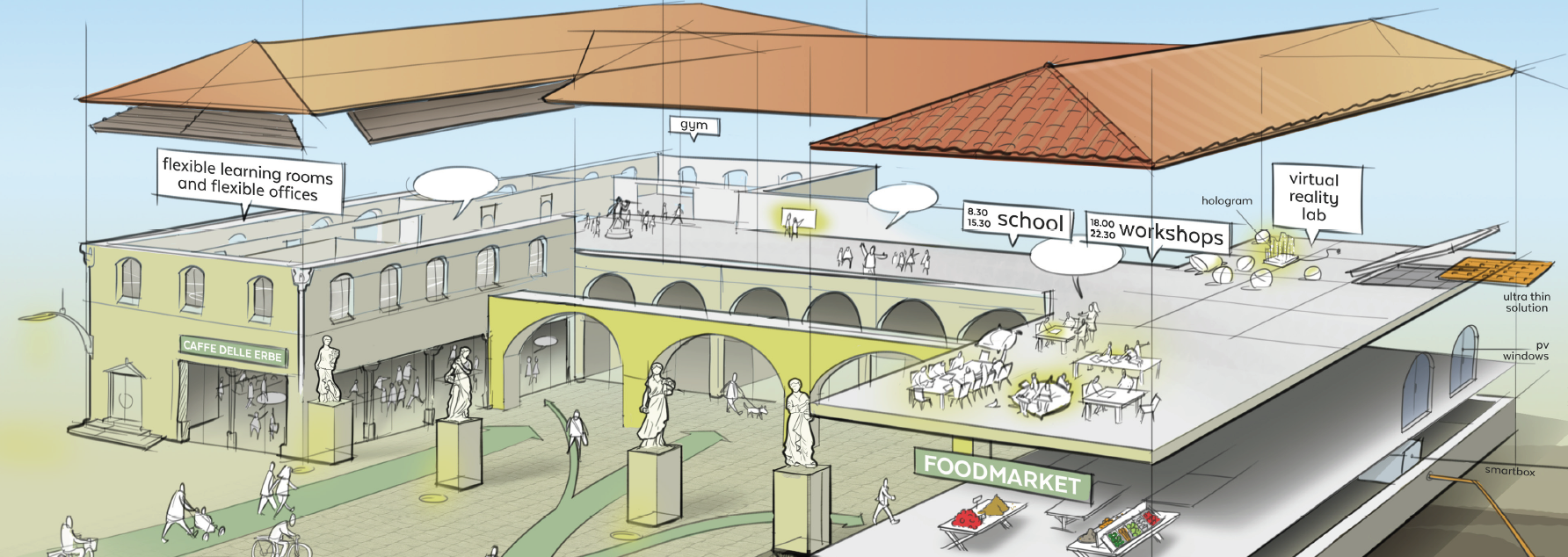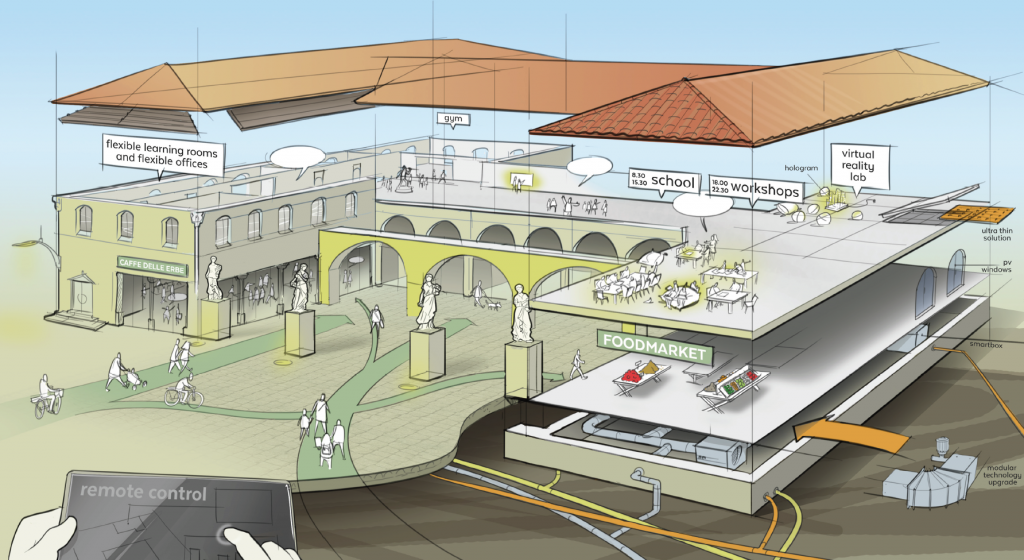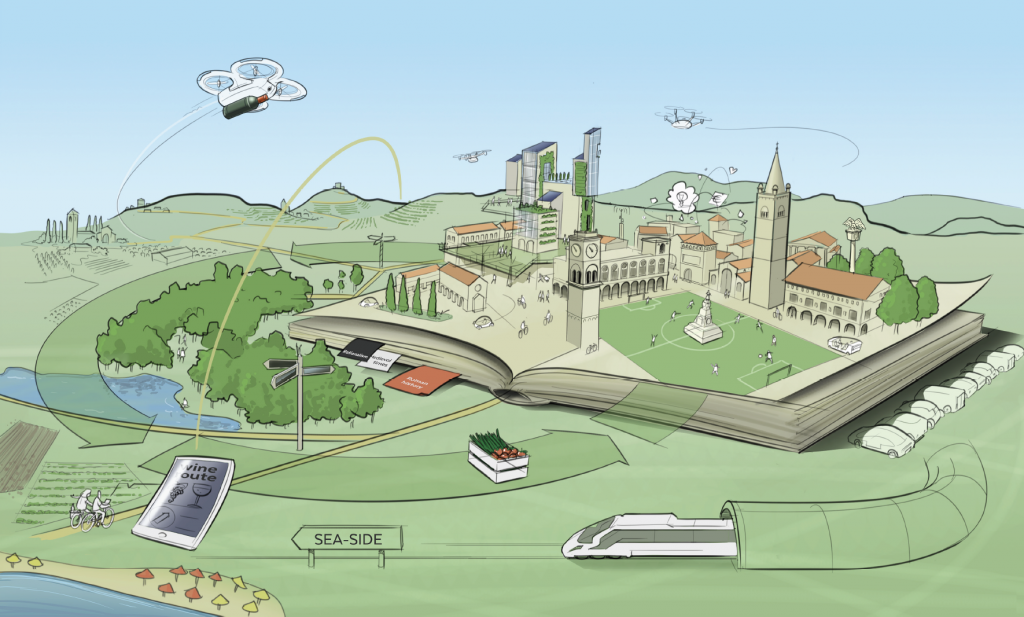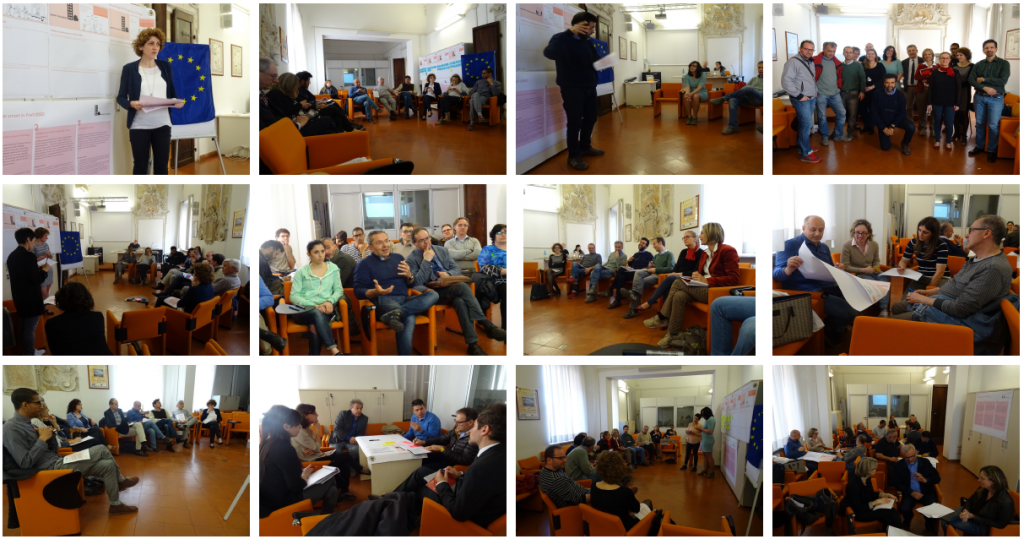Forli Vision Development 2050

Vision development for Forlì 2050
The R4E project has completed the “Vision development” stage, which consisted of designing the services and characteristics that our cities should offer in the year 2050, based on the opinions and contributions of municipal experts of each city, their stakeholders, politicians and municipal managers. To better illustrate the process, images have been created that reflect the way our cities could look in 2050, including the services and characteristics agreed upon in the workshops for each of the project’s focus areas.
HISTORY MADE SMART IN FORLÌ 2050
In 2050, people in Forlì value their historical heritage. Historical buildings are renovated with respect for their heritage, and have new uses that serve the community. Forlì boldly implement modern energy-efficient building technologies, both in top-quality new buildings and in the less valuable elements of existing buildings. All buildings are designed or renovated for safety and resilience to both normal climatic conditions and exceptional natural events.
The social environment of Forlì is supported by the technological infrastructure. People — both citizens and entrepreneurs — value high-quality connectivity and technical infrastructure. They interact with the urban space, and have real-time information inviting them to engage in social activities. The top-level infrastructure of Forlì attracts companies (both established and start-up) to set up their activities and contribute to the local economy.
The smart people of Forlì value energy-efficient buildings. Schools and hospitals are leading examples of ‘people smart’ services that encourage learning and healing. Starting as young children, people are aware of the basic principles of sustainable living that has spread across the whole city. New technologies are used to achieve zero-emission, self-sufficient buildings.
What characterises the city of Forlì in the focus areas of Smart Buildings and Smart Urban Spaces and the elements of the desired future scenario are:
1. Historical memory
Historical buildings are renovated with respect for their heritage. There are no standard rules: each building has a different social and cultural background that is revived while it is transformed it to the needs of 2050. Both the building itself and its historical value are preserved, although with an up-to-date meaning of its function. For example, the church may become a museum or a theatre, thereby maintaining the function of connecting citizens.
2. High-tech blended with history
Superb buildings maximise comfort for the users and facilitate building management because they use the latest technology for building automation, air quality control, renewable materials and efficient installations. Less invasive systems (e.g. pipeless, very thin or upgradeable modular solutions) are used for historical buildings to preserve valuable elements such as frescos. IT systems monitor the use of spaces, and manage energy at a district scale.
3. Economic development
The economy is flourishing with new businesses that create community value. Entrepreneurs develop new sharing services for citizens, thereby reducing the use of land and environmental resources. Citizens have a different mind-set and reduce their footprint actively by choosing sustainable energy, locally produced food and shared services. Districts are designed and buildings are renovated to create more efficient spaces for sharing and growing food.
4. Shared & versatile spaces
Buildings and spaces are versatile, so they can be used by the community for different purposes on a 24/7 basis . For example the building adapts to a new concept of open schooling for children. Spaces are also better integrated to facilitate lifelong learning for people of all ages, with different programmes at different times of the day and the year. The design of the buildings enables extra functionality and versatility for different purposes, users and contexts.
5. Communicating examples
Good practices and leading examples are shared in the community and transformed into solutions for common use in other buildings. Public buildings (e.g. schools and hospitals) demonstrate the basic principles of sustainable construction and provide open platforms for citizens to engage in discussions about sustainable living. Children learn about environmental systems, which inspires conscious and sustainable lifestyles as adults.
RENEWED, THRIVING CITY LIFE IN FORLÌ 2050
In 2050, the people in Forlì enjoy a compact, well-planned city with a lively centre. The city offers many well-connected, well-equipped green spaces that enhance social life.
The city has regained its primary role as a social, business and residential hub. History and culture are respected, contributing to the attractiveness of the city and its central role in the territory.
The people of Forlì benefit from the results of open territorial cooperation that encourages innovation and contributes to the city’s economic development. At the same time the soil is protected for agricultural use and leisure activities.
1. Enhancing social interaction
City planning focuses on providing spaces for social engagement. The functionality of urban space has been redefined in line with people’s needs in 2050, such as sports and playing facilities on the city squares, outdoor social games (interactive graffiti wall) and vegetable gardens. Citizens are encouraged to initiate and participate in social events through open platforms. The university campus has become an open meeting place for students and citizens.
2. A lively city centre
Shops in the centre offer modern handicrafts and other products with local production facilities. There are also other commercial activities offering dedicated services, such as smart home delivery (roof-to-roof delivery). Residents and entrepreneurs participate in identifying and creating new solutions to improve city life. This also encourages and enables young start-ups to set up new businesses offering and using technology services.
3. Historical value in a new way
Citizens enjoy ‘slow mobility’ (walking, cycling and automated vehicles), allowing more attractively designed streets. The heritage is valued as a common responsibility. Citizens, the administration and other stakeholders participate in planning and designing for new purposes. Sustainable and responsible development starts by considering all the pages (‘black’ and ‘white’) of Forlì’s history.
4. A compact city
The urban fabric features taller and more efficient buildings, while preserving and enhancing unique historical assets. The new buildings offer modern city facilities: they produce and store (renewable) energy, provide vertical vegetable gardens, and green surfaces that reduce heat stress and recover rainwater. In this way the city footprint is reduced and the agricultural function of the countryside is restored.
5. Territorial connectivity
Forlì provides a well-designed network of routes, exploring nature, culture, sports and local wine, food and handicrafts. The routes respond to the demand for a quality lifestyle supported by smart technologies. Better and faster links allow full connectivity to seaside resorts and nearby cities. Forlì’s central role in services (e.g. hospital, airport) reaches its full potential with efficient and sustainable transport.
All these ideas and input have emerged from the participatory workshops that have taken place in the city of Forlì and whose images can be seen below:



Leave a Comment